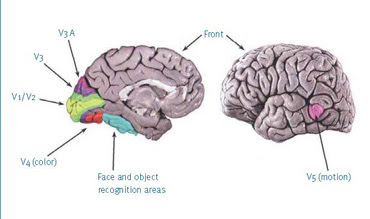Neurobiologist Semir Zeki, author of Inner Vision has shown that different features of the visual world are processed in different specialized areas of the brain.
has shown that different features of the visual world are processed in different specialized areas of the brain.

Distinct regions in the back of the brain are employed to resolve color, edges, form, and motion. After a period of time, these separate components of vision are reconstituted into a single unified experience, called a percept.

But this parallel processing happens at different speeds. According to Zeki, color is perceived before form, and form before motion. There's a 60 to 80 millisecond lag between color and motion. That lag is not an issue with still images or with film scenes with very little motion.
But if you have a scene with a lot of different bright colors moving around at a rapid rate, the lag could be an issue. In that case, as Zeki puts it, "the brain does not seem capable of binding together what happens in real time." Eighty milliseconds translates to two frames in a 24-frame-per-second film, and four frames in a film running at 48 frames per second.

I wonder if that's why so many action sequences in modern films are composed in monochromatic colors? Just a hunch.
-----
Brain diagram from Inner Vision: An Exploration of Art and the Brain
Stills from the Hobbit, courtesy Warner Brothers
Không có nhận xét nào:
Đăng nhận xét